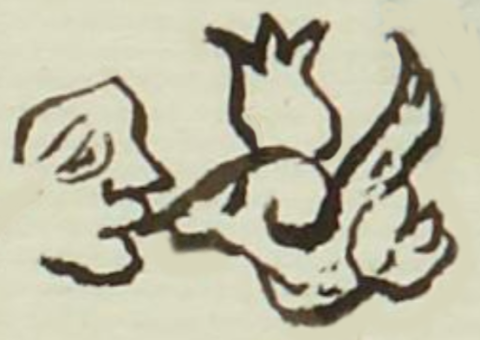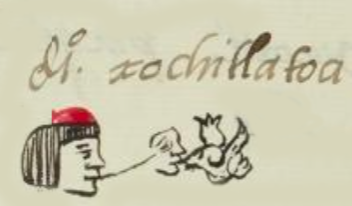Xochitlatoa (MH873v)
This black-line drawing of the simplex glyph for the personal name Xochitlatoa (literally, “He Speaks Flowers”) is attested here as a man’s name. The glyph shows the face of a man in profile, looking toward the viewer’s right. Coming out of his mouth is a large curling speech scroll (for the verb, tlatoa, to speak). A flower (xochitl) with three-visible petals sits on top of the volute and another one appears on the right side. There is an additional element to the scroll or next to it that is difficult to discern.
Stephanie Wood
Flowery speech is a known form of speech. In contemporary Nahuatl, one with flowery speech is a poet. [See: Delfino Hernández Hernández, “Xochitlajtouani: El Poeta,” in Yancuic Nahua Zazanilli: Nueva Narrativa, Mexico City: Universidad Nacional Autónoma de México, Instituto de Investigaciones Históricas, 1985.] Pamela Sandstrom says of flowery speech: "We do know that poetic, well-arranged words in the Nahuatl language were believed to be exceptionally powerful tools for addressing deities and setting things right. Flowery speech coupled with ritual action were the most effective means the Aztecs possessed to keep the forces of chaos at bay." [See her answer to a question published by Mexicolore in 2021.] Other glyphs for the name Xochitlatoa appear below. Apparently, it is not a requirement to include a speech scroll.
Stephanie Wood
dio xochitlatoa
Diego Xochitlatoa
Stephanie Wood
1560
Jeff Haskett-Wood
flores, palabras floridas. idiomas, lenguaje, poesía, nombres de hombre

xochi(tl), flowers, https://nahuatl.wired-humanities.org/content/xochitl
tlatoa, to speak, https://nahuatl.wired-humanities.org/content/tlatoa-0
posiblemente, Él Habla en Flores
Stephanie Wood
Matrícula de Huexotzinco, folio 873v, World Digital Library, https://www.loc.gov/resource/gdcwdl.wdl_15282/?sp=819&st=image.
This manuscript is hosted by the Library of Congress and the World Digital Library; used here with the Creative Commons, “Attribution-NonCommercial-ShareAlike 3.0 License” (CC-BY-NC-SAq 3.0).





